Reflective Essay on Intersectionality and Healthcare Discrimination
VerifiedAdded on 2022/10/02
|7
|1772
|17
Essay
AI Summary
This reflective essay examines the concept of intersectionality within the context of healthcare, focusing on the author's personal experiences as a Nepali male from a CALD background. The essay explores how interlocking systems of power, including gender norms, cultural expectations, and racial biases, contribute to discrimination within healthcare settings. It highlights the importance of cultural safety, the removal of discriminatory barriers, and the implementation of strategies to avoid bias. The author advocates for healthcare advocacy activities, new policies, and increased awareness to promote equitable healthcare outcomes for marginalized communities, particularly those from CALD backgrounds. The essay draws on various academic sources to support its arguments and emphasizes the need for healthcare providers to be mindful of biases and to strive for culturally safe practices to ensure all individuals receive equal quality of treatment.
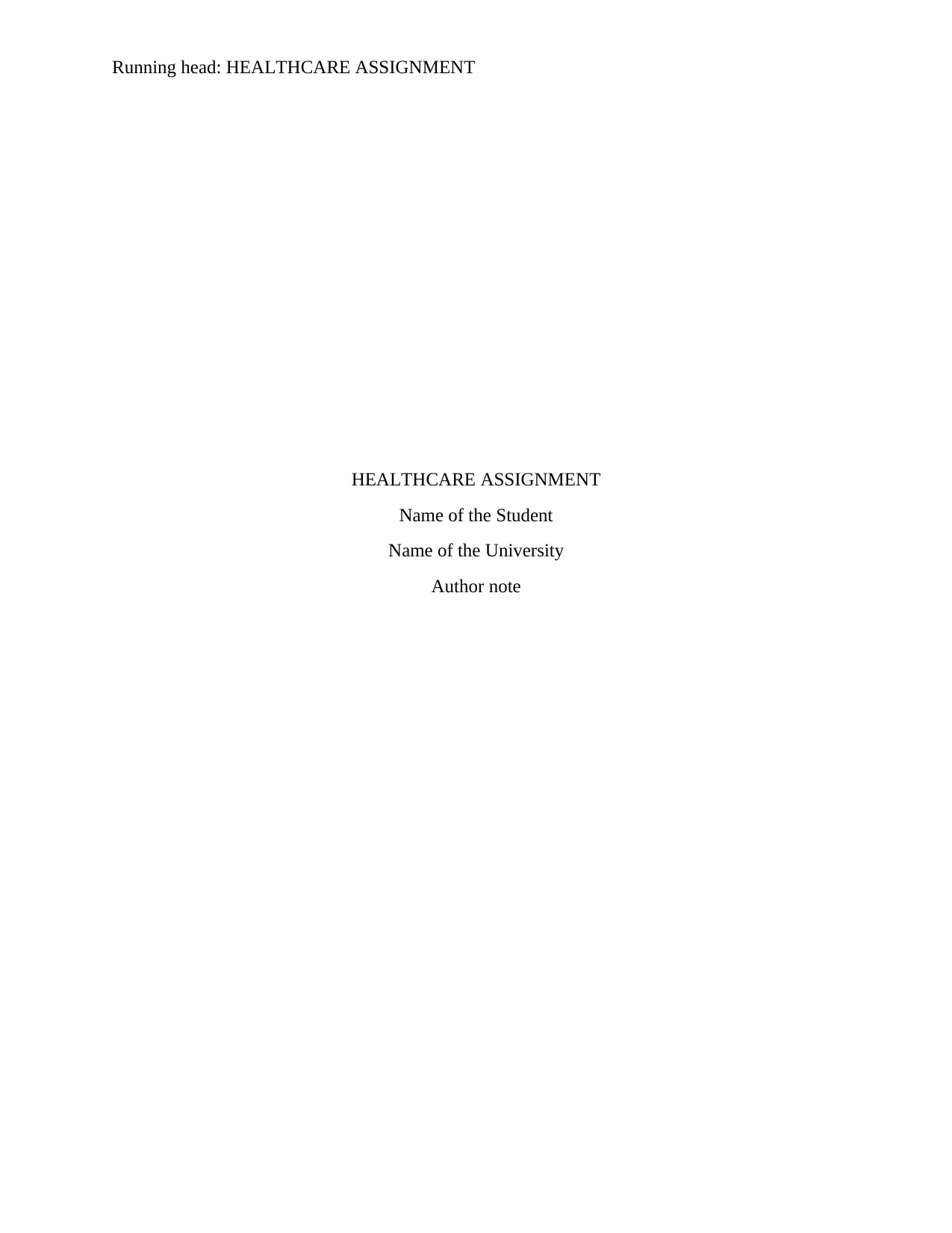
Running head: HEALTHCARE ASSIGNMENT
HEALTHCARE ASSIGNMENT
Name of the Student
Name of the University
Author note
HEALTHCARE ASSIGNMENT
Name of the Student
Name of the University
Author note
Paraphrase This Document
Need a fresh take? Get an instant paraphrase of this document with our AI Paraphraser
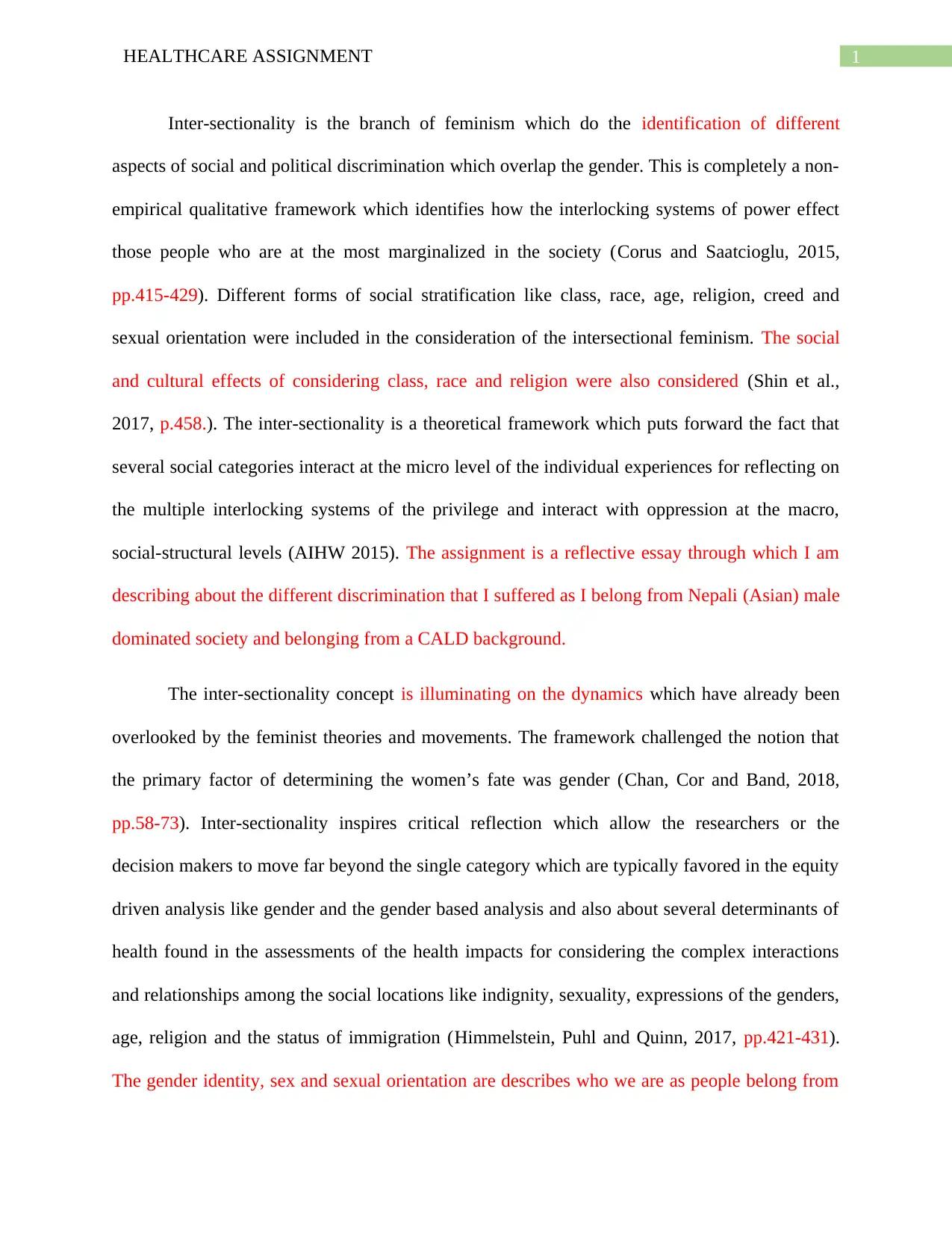
1HEALTHCARE ASSIGNMENT
Inter-sectionality is the branch of feminism which do the identification of different
aspects of social and political discrimination which overlap the gender. This is completely a non-
empirical qualitative framework which identifies how the interlocking systems of power effect
those people who are at the most marginalized in the society (Corus and Saatcioglu, 2015,
pp.415-429). Different forms of social stratification like class, race, age, religion, creed and
sexual orientation were included in the consideration of the intersectional feminism. The social
and cultural effects of considering class, race and religion were also considered (Shin et al.,
2017, p.458.). The inter-sectionality is a theoretical framework which puts forward the fact that
several social categories interact at the micro level of the individual experiences for reflecting on
the multiple interlocking systems of the privilege and interact with oppression at the macro,
social-structural levels (AIHW 2015). The assignment is a reflective essay through which I am
describing about the different discrimination that I suffered as I belong from Nepali (Asian) male
dominated society and belonging from a CALD background.
The inter-sectionality concept is illuminating on the dynamics which have already been
overlooked by the feminist theories and movements. The framework challenged the notion that
the primary factor of determining the women’s fate was gender (Chan, Cor and Band, 2018,
pp.58-73). Inter-sectionality inspires critical reflection which allow the researchers or the
decision makers to move far beyond the single category which are typically favored in the equity
driven analysis like gender and the gender based analysis and also about several determinants of
health found in the assessments of the health impacts for considering the complex interactions
and relationships among the social locations like indignity, sexuality, expressions of the genders,
age, religion and the status of immigration (Himmelstein, Puhl and Quinn, 2017, pp.421-431).
The gender identity, sex and sexual orientation are describes who we are as people belong from
Inter-sectionality is the branch of feminism which do the identification of different
aspects of social and political discrimination which overlap the gender. This is completely a non-
empirical qualitative framework which identifies how the interlocking systems of power effect
those people who are at the most marginalized in the society (Corus and Saatcioglu, 2015,
pp.415-429). Different forms of social stratification like class, race, age, religion, creed and
sexual orientation were included in the consideration of the intersectional feminism. The social
and cultural effects of considering class, race and religion were also considered (Shin et al.,
2017, p.458.). The inter-sectionality is a theoretical framework which puts forward the fact that
several social categories interact at the micro level of the individual experiences for reflecting on
the multiple interlocking systems of the privilege and interact with oppression at the macro,
social-structural levels (AIHW 2015). The assignment is a reflective essay through which I am
describing about the different discrimination that I suffered as I belong from Nepali (Asian) male
dominated society and belonging from a CALD background.
The inter-sectionality concept is illuminating on the dynamics which have already been
overlooked by the feminist theories and movements. The framework challenged the notion that
the primary factor of determining the women’s fate was gender (Chan, Cor and Band, 2018,
pp.58-73). Inter-sectionality inspires critical reflection which allow the researchers or the
decision makers to move far beyond the single category which are typically favored in the equity
driven analysis like gender and the gender based analysis and also about several determinants of
health found in the assessments of the health impacts for considering the complex interactions
and relationships among the social locations like indignity, sexuality, expressions of the genders,
age, religion and the status of immigration (Himmelstein, Puhl and Quinn, 2017, pp.421-431).
The gender identity, sex and sexual orientation are describes who we are as people belong from
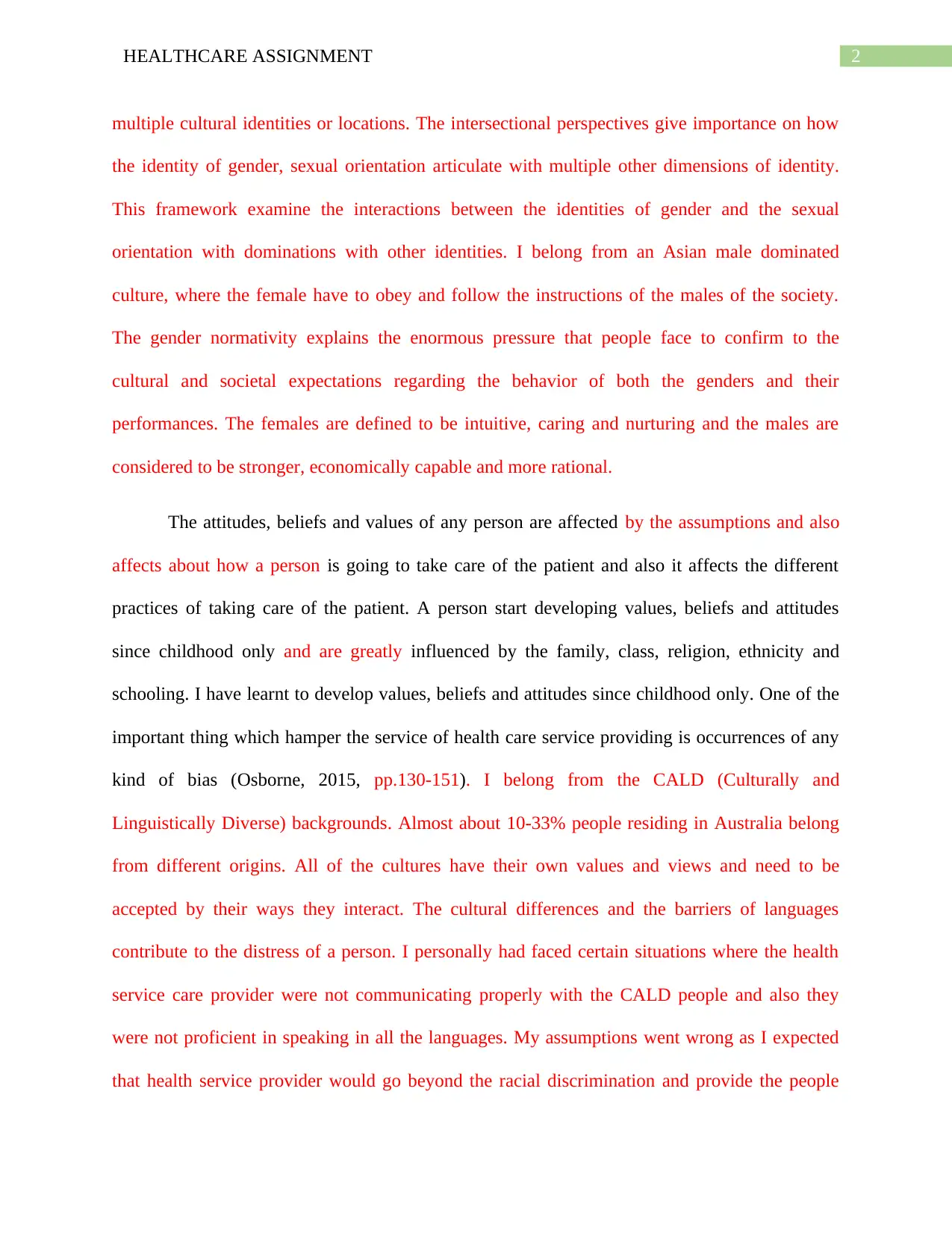
2HEALTHCARE ASSIGNMENT
multiple cultural identities or locations. The intersectional perspectives give importance on how
the identity of gender, sexual orientation articulate with multiple other dimensions of identity.
This framework examine the interactions between the identities of gender and the sexual
orientation with dominations with other identities. I belong from an Asian male dominated
culture, where the female have to obey and follow the instructions of the males of the society.
The gender normativity explains the enormous pressure that people face to confirm to the
cultural and societal expectations regarding the behavior of both the genders and their
performances. The females are defined to be intuitive, caring and nurturing and the males are
considered to be stronger, economically capable and more rational.
The attitudes, beliefs and values of any person are affected by the assumptions and also
affects about how a person is going to take care of the patient and also it affects the different
practices of taking care of the patient. A person start developing values, beliefs and attitudes
since childhood only and are greatly influenced by the family, class, religion, ethnicity and
schooling. I have learnt to develop values, beliefs and attitudes since childhood only. One of the
important thing which hamper the service of health care service providing is occurrences of any
kind of bias (Osborne, 2015, pp.130-151). I belong from the CALD (Culturally and
Linguistically Diverse) backgrounds. Almost about 10-33% people residing in Australia belong
from different origins. All of the cultures have their own values and views and need to be
accepted by their ways they interact. The cultural differences and the barriers of languages
contribute to the distress of a person. I personally had faced certain situations where the health
service care provider were not communicating properly with the CALD people and also they
were not proficient in speaking in all the languages. My assumptions went wrong as I expected
that health service provider would go beyond the racial discrimination and provide the people
multiple cultural identities or locations. The intersectional perspectives give importance on how
the identity of gender, sexual orientation articulate with multiple other dimensions of identity.
This framework examine the interactions between the identities of gender and the sexual
orientation with dominations with other identities. I belong from an Asian male dominated
culture, where the female have to obey and follow the instructions of the males of the society.
The gender normativity explains the enormous pressure that people face to confirm to the
cultural and societal expectations regarding the behavior of both the genders and their
performances. The females are defined to be intuitive, caring and nurturing and the males are
considered to be stronger, economically capable and more rational.
The attitudes, beliefs and values of any person are affected by the assumptions and also
affects about how a person is going to take care of the patient and also it affects the different
practices of taking care of the patient. A person start developing values, beliefs and attitudes
since childhood only and are greatly influenced by the family, class, religion, ethnicity and
schooling. I have learnt to develop values, beliefs and attitudes since childhood only. One of the
important thing which hamper the service of health care service providing is occurrences of any
kind of bias (Osborne, 2015, pp.130-151). I belong from the CALD (Culturally and
Linguistically Diverse) backgrounds. Almost about 10-33% people residing in Australia belong
from different origins. All of the cultures have their own values and views and need to be
accepted by their ways they interact. The cultural differences and the barriers of languages
contribute to the distress of a person. I personally had faced certain situations where the health
service care provider were not communicating properly with the CALD people and also they
were not proficient in speaking in all the languages. My assumptions went wrong as I expected
that health service provider would go beyond the racial discrimination and provide the people
⊘ This is a preview!⊘
Do you want full access?
Subscribe today to unlock all pages.

Trusted by 1+ million students worldwide
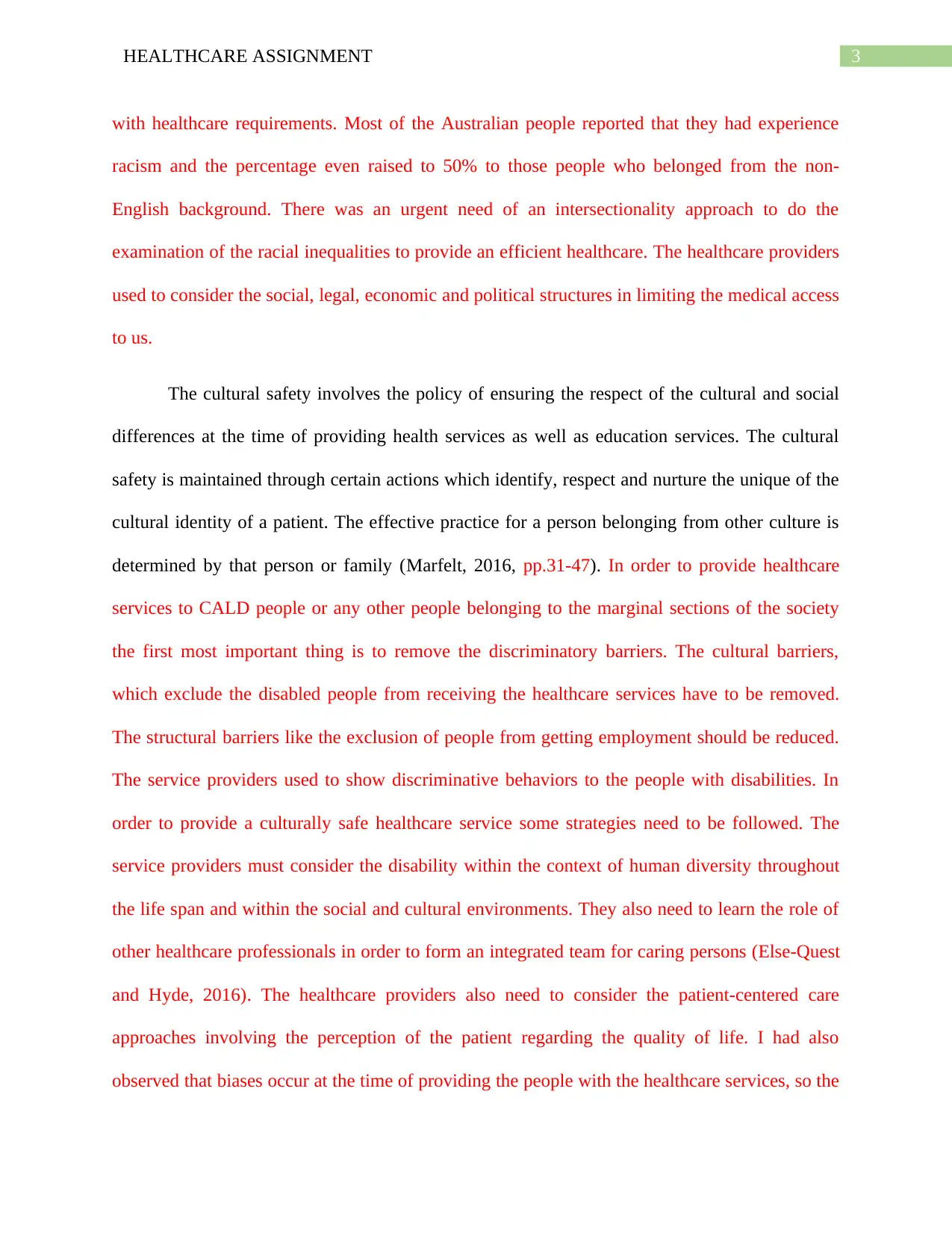
3HEALTHCARE ASSIGNMENT
with healthcare requirements. Most of the Australian people reported that they had experience
racism and the percentage even raised to 50% to those people who belonged from the non-
English background. There was an urgent need of an intersectionality approach to do the
examination of the racial inequalities to provide an efficient healthcare. The healthcare providers
used to consider the social, legal, economic and political structures in limiting the medical access
to us.
The cultural safety involves the policy of ensuring the respect of the cultural and social
differences at the time of providing health services as well as education services. The cultural
safety is maintained through certain actions which identify, respect and nurture the unique of the
cultural identity of a patient. The effective practice for a person belonging from other culture is
determined by that person or family (Marfelt, 2016, pp.31-47). In order to provide healthcare
services to CALD people or any other people belonging to the marginal sections of the society
the first most important thing is to remove the discriminatory barriers. The cultural barriers,
which exclude the disabled people from receiving the healthcare services have to be removed.
The structural barriers like the exclusion of people from getting employment should be reduced.
The service providers used to show discriminative behaviors to the people with disabilities. In
order to provide a culturally safe healthcare service some strategies need to be followed. The
service providers must consider the disability within the context of human diversity throughout
the life span and within the social and cultural environments. They also need to learn the role of
other healthcare professionals in order to form an integrated team for caring persons (Else-Quest
and Hyde, 2016). The healthcare providers also need to consider the patient-centered care
approaches involving the perception of the patient regarding the quality of life. I had also
observed that biases occur at the time of providing the people with the healthcare services, so the
with healthcare requirements. Most of the Australian people reported that they had experience
racism and the percentage even raised to 50% to those people who belonged from the non-
English background. There was an urgent need of an intersectionality approach to do the
examination of the racial inequalities to provide an efficient healthcare. The healthcare providers
used to consider the social, legal, economic and political structures in limiting the medical access
to us.
The cultural safety involves the policy of ensuring the respect of the cultural and social
differences at the time of providing health services as well as education services. The cultural
safety is maintained through certain actions which identify, respect and nurture the unique of the
cultural identity of a patient. The effective practice for a person belonging from other culture is
determined by that person or family (Marfelt, 2016, pp.31-47). In order to provide healthcare
services to CALD people or any other people belonging to the marginal sections of the society
the first most important thing is to remove the discriminatory barriers. The cultural barriers,
which exclude the disabled people from receiving the healthcare services have to be removed.
The structural barriers like the exclusion of people from getting employment should be reduced.
The service providers used to show discriminative behaviors to the people with disabilities. In
order to provide a culturally safe healthcare service some strategies need to be followed. The
service providers must consider the disability within the context of human diversity throughout
the life span and within the social and cultural environments. They also need to learn the role of
other healthcare professionals in order to form an integrated team for caring persons (Else-Quest
and Hyde, 2016). The healthcare providers also need to consider the patient-centered care
approaches involving the perception of the patient regarding the quality of life. I had also
observed that biases occur at the time of providing the people with the healthcare services, so the
Paraphrase This Document
Need a fresh take? Get an instant paraphrase of this document with our AI Paraphraser
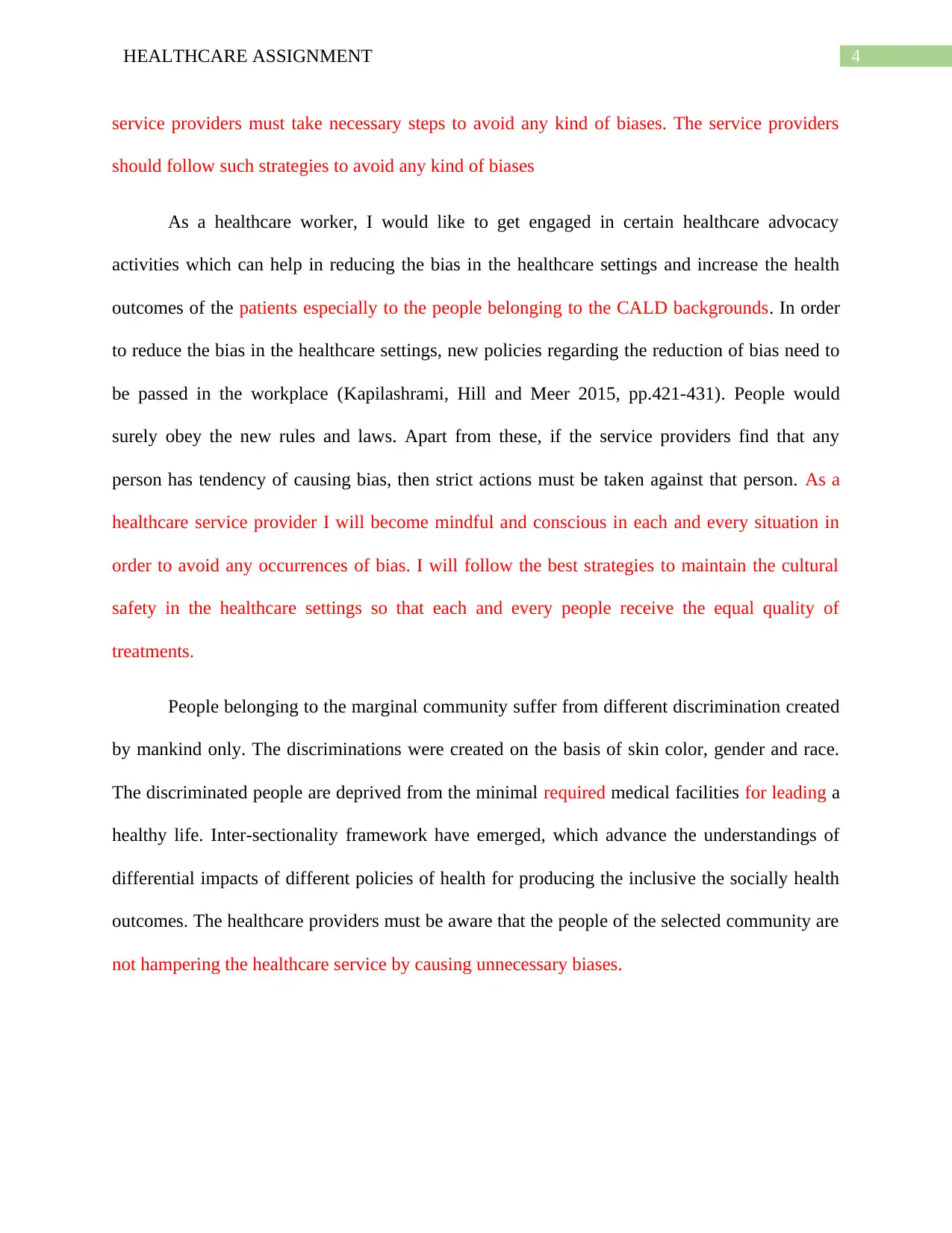
4HEALTHCARE ASSIGNMENT
service providers must take necessary steps to avoid any kind of biases. The service providers
should follow such strategies to avoid any kind of biases
As a healthcare worker, I would like to get engaged in certain healthcare advocacy
activities which can help in reducing the bias in the healthcare settings and increase the health
outcomes of the patients especially to the people belonging to the CALD backgrounds. In order
to reduce the bias in the healthcare settings, new policies regarding the reduction of bias need to
be passed in the workplace (Kapilashrami, Hill and Meer 2015, pp.421-431). People would
surely obey the new rules and laws. Apart from these, if the service providers find that any
person has tendency of causing bias, then strict actions must be taken against that person. As a
healthcare service provider I will become mindful and conscious in each and every situation in
order to avoid any occurrences of bias. I will follow the best strategies to maintain the cultural
safety in the healthcare settings so that each and every people receive the equal quality of
treatments.
People belonging to the marginal community suffer from different discrimination created
by mankind only. The discriminations were created on the basis of skin color, gender and race.
The discriminated people are deprived from the minimal required medical facilities for leading a
healthy life. Inter-sectionality framework have emerged, which advance the understandings of
differential impacts of different policies of health for producing the inclusive the socially health
outcomes. The healthcare providers must be aware that the people of the selected community are
not hampering the healthcare service by causing unnecessary biases.
service providers must take necessary steps to avoid any kind of biases. The service providers
should follow such strategies to avoid any kind of biases
As a healthcare worker, I would like to get engaged in certain healthcare advocacy
activities which can help in reducing the bias in the healthcare settings and increase the health
outcomes of the patients especially to the people belonging to the CALD backgrounds. In order
to reduce the bias in the healthcare settings, new policies regarding the reduction of bias need to
be passed in the workplace (Kapilashrami, Hill and Meer 2015, pp.421-431). People would
surely obey the new rules and laws. Apart from these, if the service providers find that any
person has tendency of causing bias, then strict actions must be taken against that person. As a
healthcare service provider I will become mindful and conscious in each and every situation in
order to avoid any occurrences of bias. I will follow the best strategies to maintain the cultural
safety in the healthcare settings so that each and every people receive the equal quality of
treatments.
People belonging to the marginal community suffer from different discrimination created
by mankind only. The discriminations were created on the basis of skin color, gender and race.
The discriminated people are deprived from the minimal required medical facilities for leading a
healthy life. Inter-sectionality framework have emerged, which advance the understandings of
differential impacts of different policies of health for producing the inclusive the socially health
outcomes. The healthcare providers must be aware that the people of the selected community are
not hampering the healthcare service by causing unnecessary biases.
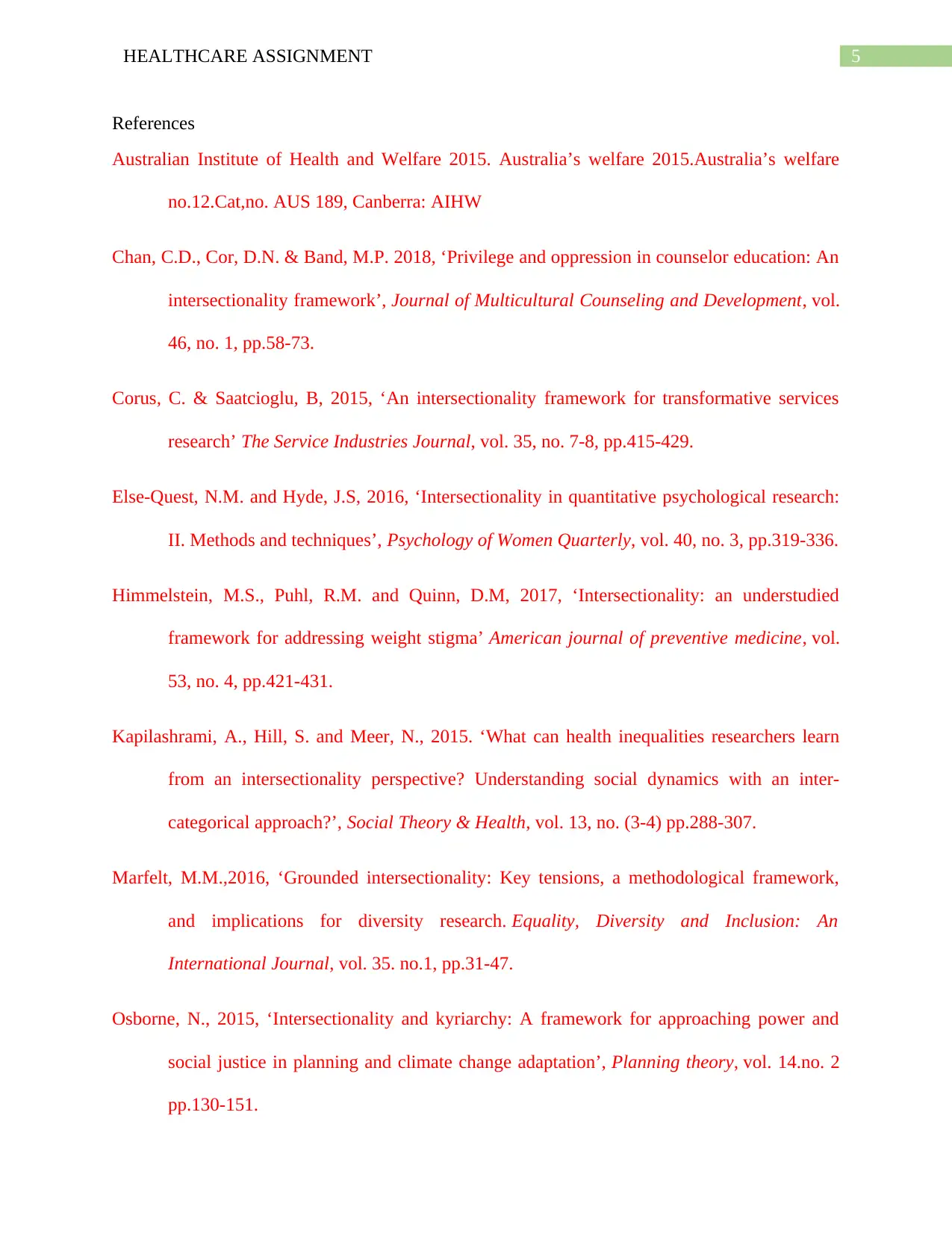
5HEALTHCARE ASSIGNMENT
References
Australian Institute of Health and Welfare 2015. Australia’s welfare 2015.Australia’s welfare
no.12.Cat,no. AUS 189, Canberra: AIHW
Chan, C.D., Cor, D.N. & Band, M.P. 2018, ‘Privilege and oppression in counselor education: An
intersectionality framework’, Journal of Multicultural Counseling and Development, vol.
46, no. 1, pp.58-73.
Corus, C. & Saatcioglu, B, 2015, ‘An intersectionality framework for transformative services
research’ The Service Industries Journal, vol. 35, no. 7-8, pp.415-429.
Else-Quest, N.M. and Hyde, J.S, 2016, ‘Intersectionality in quantitative psychological research:
II. Methods and techniques’, Psychology of Women Quarterly, vol. 40, no. 3, pp.319-336.
Himmelstein, M.S., Puhl, R.M. and Quinn, D.M, 2017, ‘Intersectionality: an understudied
framework for addressing weight stigma’ American journal of preventive medicine, vol.
53, no. 4, pp.421-431.
Kapilashrami, A., Hill, S. and Meer, N., 2015. ‘What can health inequalities researchers learn
from an intersectionality perspective? Understanding social dynamics with an inter-
categorical approach?’, Social Theory & Health, vol. 13, no. (3-4) pp.288-307.
Marfelt, M.M.,2016, ‘Grounded intersectionality: Key tensions, a methodological framework,
and implications for diversity research. Equality, Diversity and Inclusion: An
International Journal, vol. 35. no.1, pp.31-47.
Osborne, N., 2015, ‘Intersectionality and kyriarchy: A framework for approaching power and
social justice in planning and climate change adaptation’, Planning theory, vol. 14.no. 2
pp.130-151.
References
Australian Institute of Health and Welfare 2015. Australia’s welfare 2015.Australia’s welfare
no.12.Cat,no. AUS 189, Canberra: AIHW
Chan, C.D., Cor, D.N. & Band, M.P. 2018, ‘Privilege and oppression in counselor education: An
intersectionality framework’, Journal of Multicultural Counseling and Development, vol.
46, no. 1, pp.58-73.
Corus, C. & Saatcioglu, B, 2015, ‘An intersectionality framework for transformative services
research’ The Service Industries Journal, vol. 35, no. 7-8, pp.415-429.
Else-Quest, N.M. and Hyde, J.S, 2016, ‘Intersectionality in quantitative psychological research:
II. Methods and techniques’, Psychology of Women Quarterly, vol. 40, no. 3, pp.319-336.
Himmelstein, M.S., Puhl, R.M. and Quinn, D.M, 2017, ‘Intersectionality: an understudied
framework for addressing weight stigma’ American journal of preventive medicine, vol.
53, no. 4, pp.421-431.
Kapilashrami, A., Hill, S. and Meer, N., 2015. ‘What can health inequalities researchers learn
from an intersectionality perspective? Understanding social dynamics with an inter-
categorical approach?’, Social Theory & Health, vol. 13, no. (3-4) pp.288-307.
Marfelt, M.M.,2016, ‘Grounded intersectionality: Key tensions, a methodological framework,
and implications for diversity research. Equality, Diversity and Inclusion: An
International Journal, vol. 35. no.1, pp.31-47.
Osborne, N., 2015, ‘Intersectionality and kyriarchy: A framework for approaching power and
social justice in planning and climate change adaptation’, Planning theory, vol. 14.no. 2
pp.130-151.
⊘ This is a preview!⊘
Do you want full access?
Subscribe today to unlock all pages.

Trusted by 1+ million students worldwide
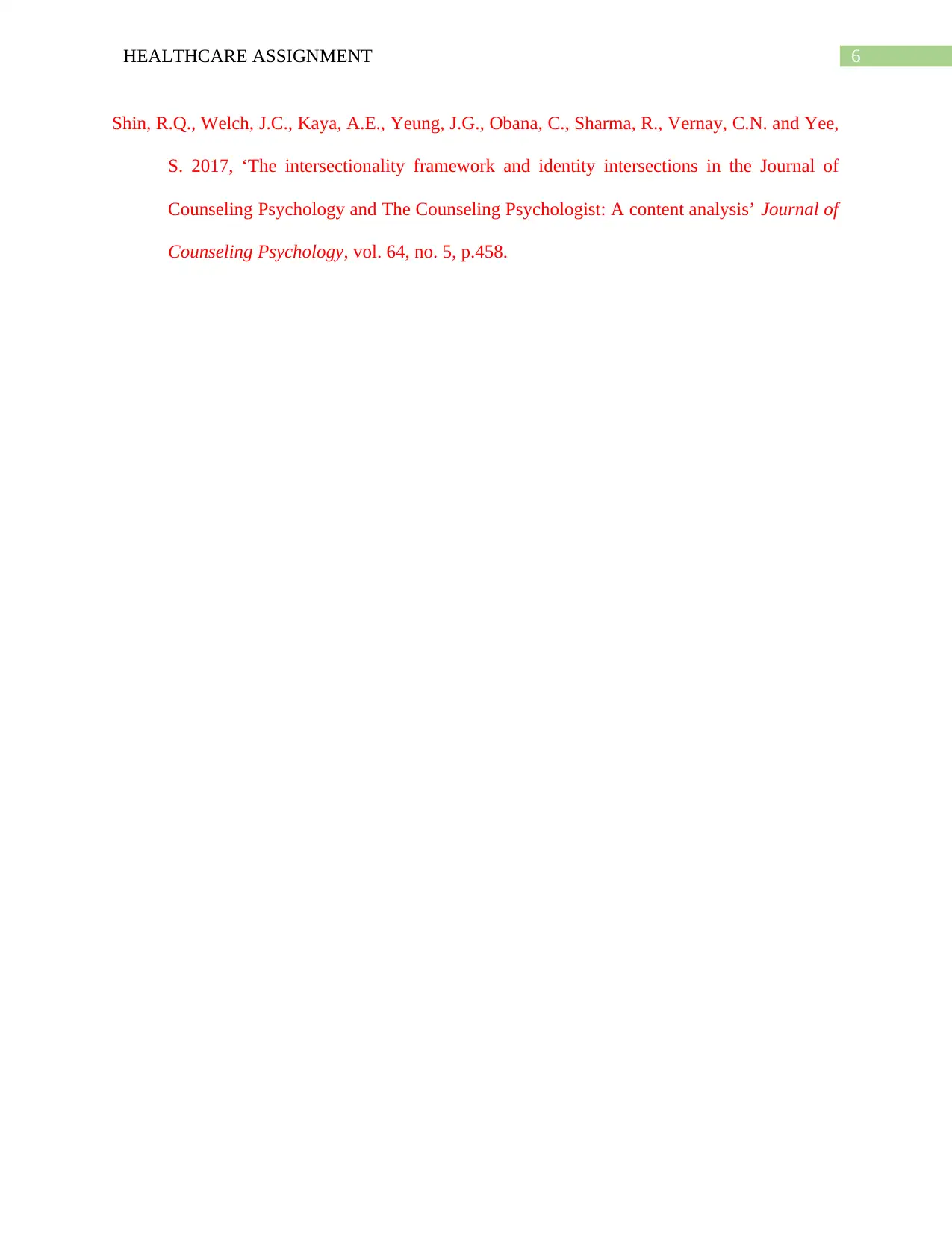
6HEALTHCARE ASSIGNMENT
Shin, R.Q., Welch, J.C., Kaya, A.E., Yeung, J.G., Obana, C., Sharma, R., Vernay, C.N. and Yee,
S. 2017, ‘The intersectionality framework and identity intersections in the Journal of
Counseling Psychology and The Counseling Psychologist: A content analysis’ Journal of
Counseling Psychology, vol. 64, no. 5, p.458.
Shin, R.Q., Welch, J.C., Kaya, A.E., Yeung, J.G., Obana, C., Sharma, R., Vernay, C.N. and Yee,
S. 2017, ‘The intersectionality framework and identity intersections in the Journal of
Counseling Psychology and The Counseling Psychologist: A content analysis’ Journal of
Counseling Psychology, vol. 64, no. 5, p.458.
1 out of 7
Related Documents
Your All-in-One AI-Powered Toolkit for Academic Success.
+13062052269
info@desklib.com
Available 24*7 on WhatsApp / Email
![[object Object]](/_next/static/media/star-bottom.7253800d.svg)
Unlock your academic potential
Copyright © 2020–2025 A2Z Services. All Rights Reserved. Developed and managed by ZUCOL.





